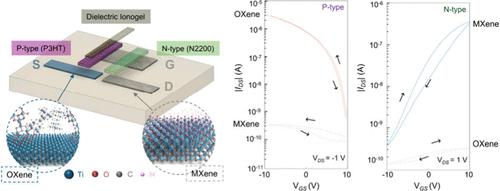二维过渡金属中的对称工程实现可重构P型和n型场效应管
IF 9.1
1区 材料科学
Q1 CHEMISTRY, MULTIDISCIPLINARY
引用次数: 0
摘要
二维(2D)过渡金属能够消除场效应晶体管(fet)中金属诱导的间隙状态和费米能级钉住,具有优于传统金属触点的优势。然而,过渡金属衬底通常表现出非定向行为,导致无法实现P或n型半导体的单语响应。在这里,我们设计了一种氧化MXene结构的对称工程,称为OXene,它实现了额外的面外电子传导和内置极性结构的开发和耦合。OXene结合了定向抑制和兴奋特性来实现可重构的FET衬底,利用金属-半导体界面的调制载流子动力学。通过将OXene与MXene耦合,我们实现了互补的半导体响应,从而在逻辑配置中引入了额外的可编程性维度。本文章由计算机程序翻译,如有差异,请以英文原文为准。

Symmetry Engineering in a 2D Transition Metal Enables Reconfigurable P- and N-Type FETs
Two-dimensional (2D) transition metals enable the elimination of metal-induced gap states and Fermi-level pinning in field-effect transistors (FETs), offering an advantage over conventional metal contacts. However, transition metal substrates typically exhibit nonoriented behaviors, leading to the inability to achieve monolingual responses with P- or N-type semiconductors. Here we devise symmetry engineering in an oxidized architectural MXene, termed OXene, which implements the exploiting and coupling of additional out-of-plane electron conduction and built-in polar structures. OXene combines oriented inhibitory and excitatory characteristics to achieve reconfigurable FET substrates, leveraging the modulation carrier dynamics at the metal–semiconductor interface. By coupling OXene with MXene, we achieve complementary semiconductor responses that introduce an additional dimension of programmability in logic configurations.
求助全文
通过发布文献求助,成功后即可免费获取论文全文。
去求助
来源期刊

Nano Letters
工程技术-材料科学:综合
CiteScore
16.80
自引率
2.80%
发文量
1182
审稿时长
1.4 months
期刊介绍:
Nano Letters serves as a dynamic platform for promptly disseminating original results in fundamental, applied, and emerging research across all facets of nanoscience and nanotechnology. A pivotal criterion for inclusion within Nano Letters is the convergence of at least two different areas or disciplines, ensuring a rich interdisciplinary scope. The journal is dedicated to fostering exploration in diverse areas, including:
- Experimental and theoretical findings on physical, chemical, and biological phenomena at the nanoscale
- Synthesis, characterization, and processing of organic, inorganic, polymer, and hybrid nanomaterials through physical, chemical, and biological methodologies
- Modeling and simulation of synthetic, assembly, and interaction processes
- Realization of integrated nanostructures and nano-engineered devices exhibiting advanced performance
- Applications of nanoscale materials in living and environmental systems
Nano Letters is committed to advancing and showcasing groundbreaking research that intersects various domains, fostering innovation and collaboration in the ever-evolving field of nanoscience and nanotechnology.
 求助内容:
求助内容: 应助结果提醒方式:
应助结果提醒方式:


